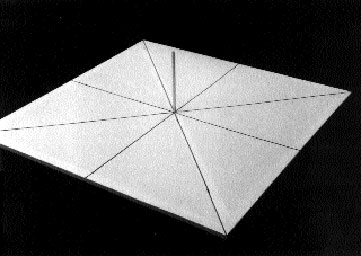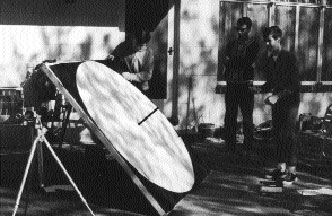|
Observe Eclipses!
|
Solar Eclipse Observing--Shadow BandsIntroduction. For a few minutes on either side of totality, when the sun is a thin crescent and the sky takes on the characteristic yellowish tint of eclipse–induced twilight, alert observers may notice eerie bands of undulating shadow racing across the ground, along the sides of buildings or across other light–colored surfaces. This atmospheric phenomenon, first described by H. Goldschmidt in 1820 but undoubtedly observed since antiquity, is believed caused by an irregular bending or refraction of the crescent sunlight. Explanations. Attempts to explain the shadow band phenomenon have focused upon the atmospheric rather than the astronomical sciences, for the bands do not reliably appear or exhibit similar behaviors at each eclipse, even when eclipses have similar geometric circumstances. In 1900, H. C. Wilson proposed a diffraction–ring hypothesis for their origin. Writing in the now–defunct magazine Popular Astronomy, Wilson maintained that a pattern of concentric rings surrounded the moon’s shadow, and the shadow band movements were caused by this pattern moving across the earth. In the November, 1925, issue of that same magazine, U.S. Weather Bureau meteorologist W. J. Humphreys reported that the bands paralleled the solar crescent and moved normally to their length during an eclipse earlier that year. He concluded that the bands were pseudo–total reflections, or mirage effects produced by transition shells between warmer and cooler adjacent masses of air in a state of thermal convection, and that there was no relation between their direction of travel and that of the winds aloft at any level. In the June, 1963, issue of Sky & Telescope magazine, Edgar Paulton of the Amateur Astronomers Association of New York City suggested their movements in such widely divergent directions, when viewed from different locations, were an illusion brought on by their rapid passage. Many observers hold strongly to the belief that changes in shadow band direction are caused by variations in atmospheric temperature, humidity, density and pressure, contending, therefore, that it would be difficult at best to predict their appearance and motions for any specific eclipse in advance. To obtain the fullest possible picture of these enigmatic bands, observations of their presence (or absence) and behaviors, along with relevant meteorological data, are desired for all total and near–total annular eclipses. Observations are also desired from all possible sites along the length and width of each eclipse path, in order to obtain comparative data for various geometries and weather conditions. Only then will a definitive explanation for shadow bands and a reliable means of predicting their likelihood of occurrence for any given eclipse be possible. Appearance. Shadow bands vary considerably in both width and separation, but range most frequently between 2 and 5 cm (0.75 and 2 in) in width and are separated from one another by 5 to 25 cm (2 to 10 in). Their direction of motion across the ground seems to depend upon where an observer is located along the eclipse path and whether the bands are observed before or after totality. Their velocities vary most often between 1.5 and 3 m (5 and 10 ft) per second. Equipment. Casual observers of shadow bands can detect them against any light–colored surface. For serious studies of the bands, however, a standardized observing procedure was developed by Paulton in 1959 to simplify comparisons of observations made from widely separated sites. Paulton’s approach calls for setting up projection screens perpendicular to the axis of the shadow cone. Each observer is then examining a tiny segment of a plane upon which the moon’s shadow appears circular. First, a portable wooden frame about 1.5 m (5 ft) square is constructed and supported by diagonal struts joined at the center. The finished frame and mount should resemble an oversized artist’s easel.
Next, the screen surface is selected. This may be a white cloth, sheet or canvas which completely covers the frame (eclipse–chaser Norm Sperling recommends sandpaper for greater contrast). A large azimuth circle, marked off and labeled in five–degree increments, is then drawn or painted onto the screen’s face. This is best done by projecting a slide or overhead transparency of an azimuth circle onto the screen and tracing the image. Finally, a rod is mounted in the center of the screen, projecting about 30 cm (12 in) out of the middle of the azimuth circle. If made of light–weight materials and designed for easy assembly and breakdown, this piece of home–made equipment can be transported and set up with a minimum of effort.
Procedures. Paulton’s ideal shadow band observing team requires three people. A few minutes before totality, the screen is oriented so that the central rod casts no shadow. When the first bands appear, the first observer stretches a length of string across the screen parallel to the length of the bands. The string may be attached to the screen with push–pins, thumb–tacks, or tape. Some have designed a more elaborate frame with hooks attached to the screen at each five–degree mark on the azimuth circle; the string is then wound around opposing hooks. If the bands do not change direction, no further action is necessary. If they do, every 30 seconds another string is attached. The strings should be prepared in advance, labeled in numerical order with masking tape flags and laid out in the order in which they are to be used. The first observer must also notice the direction of motion of the bands, which may or may not parallel their length. A twelve–hour clock face system is recommended to avoid confusion with the orientation angles on the screen. The observer might, for instance, observe the orientation of the bands as stretching between 225 degrees and 45 degrees, while their direction of motion is from 11 o’clock to 5 o’clock. The second observer, armed with a stopwatch, alerts the third observer with a pre–arranged countdown and starts the stopwatch the moment one of the bands begins its journey across the screen. At that same moment, the third observer begins counting the number of bands which cross some predetermined position on the screen, usually the edge from which the bands are leaving. Meanwhile, the second observer has been following that one shadow band across the screen. The moment the selected band leaves the screen, the second observer simultaneously stops the stopwatch and alerts observer three with another verbal signal. Observer three, upon hearing observer two’s outcry, stops counting the departing shadow bands and records the number counted. When finished, the first observer will have recorded valuable data on the orientation and direction of travel of the bands, the second observer the time of travel across the screen, and the third observer the number of bands present in the circle’s diameter at that time. Paulton has recommended that measurements be repeated at 30–second intervals for as long as shadow bands are visible, and that the entire experiment be repeated following totality. If frequent observations are planned, tape–recording the various measurements, directions and counts, preferably against a background of WWV or CHU broadcast time signals, can minimize confusion later. Paulton’s experiment is relatively simple and well suited to clubs or school classes which could be formed into several teams and located at different sites. Considerable practice by prospective team members is required to guarantee success, however. Observations from totality’s edge. Observers located near the edges of the path of totality will experience shadow bands for longer periods of time. However, since there is no guarantee that a particular eclipse will produce the bands, and since the duration of totality diminishes rapidly as the northern or southern limit of an eclipse path is approached, observers will sacrifice valuable minutes from the most spectacular part of a total eclipse. Large groups planning to send volunteer teams to these hinterlands should make certain that the participants fully understand what they’ll be giving up in totality time to obtain more information on this interesting phenomenon. Photography and Video Imaging. Dim lighting, poor contrast and rapid movement make still photography of shadow bands difficult at best. Low–light camcorders offer a significant advantage, and can be centered on the viewing screen to capture the motions of the bands for later playback and data reduction. |

